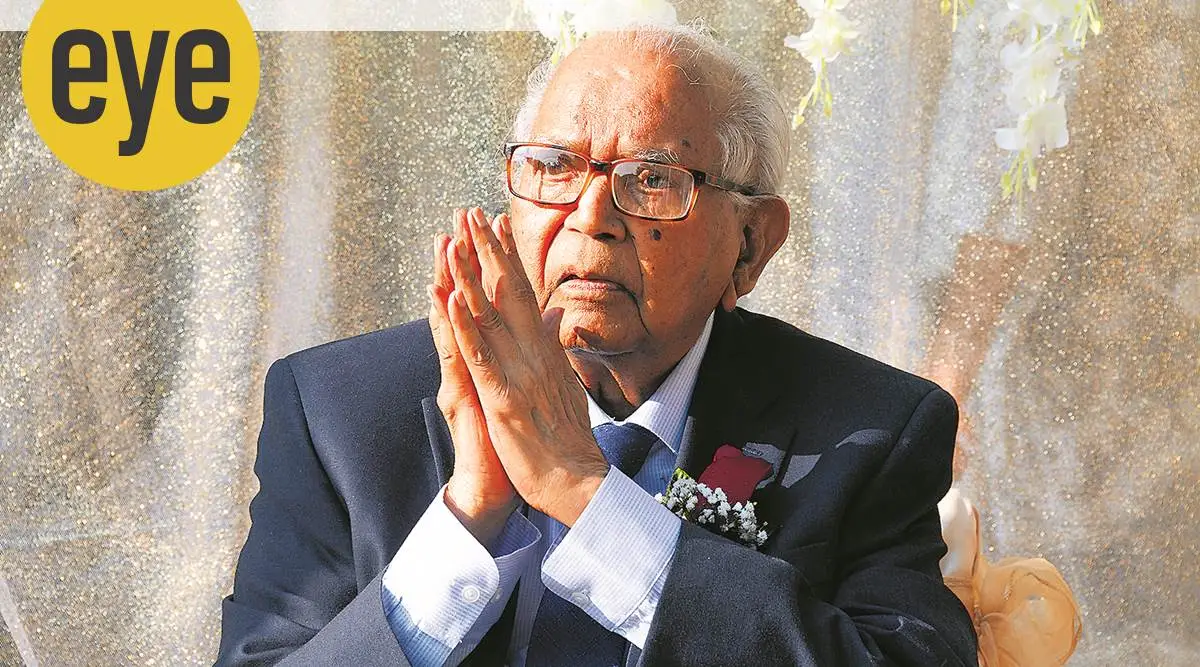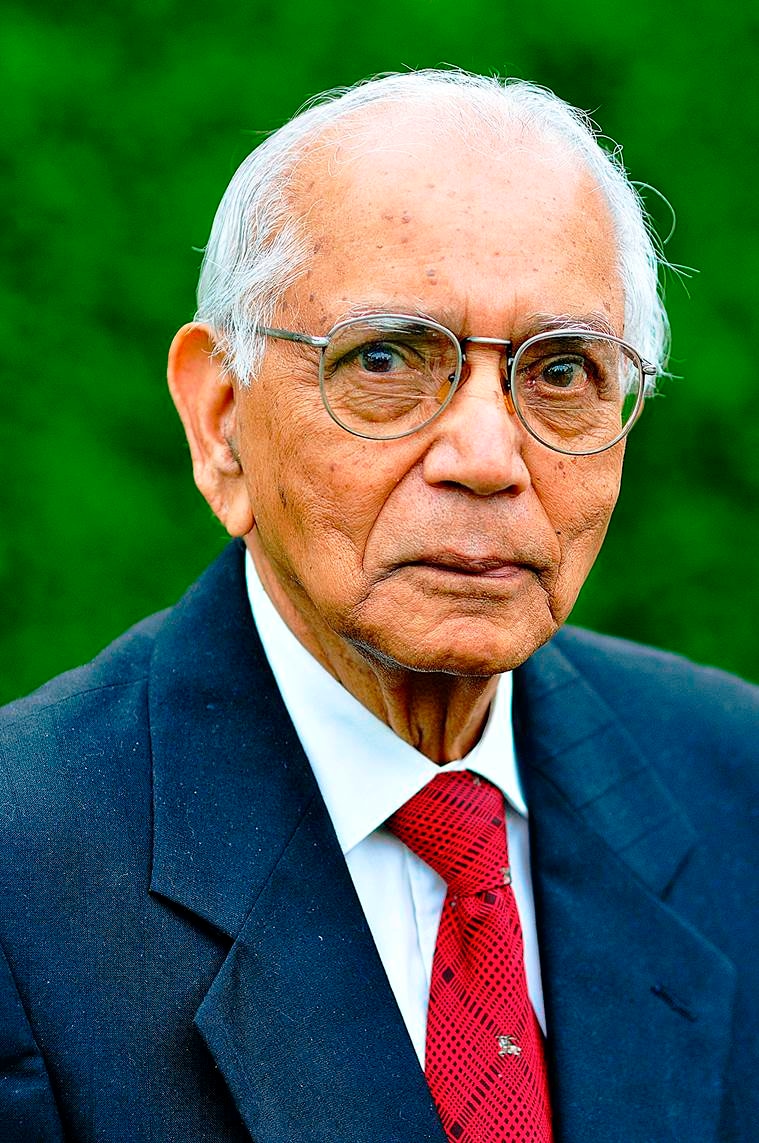 The eighth of 10 children, Rao was born in September, 1920, in Huvinna Hadagali, a town in what was then the Madras Presidency of British India. (Photo: Tejaswini Rao)
The eighth of 10 children, Rao was born in September, 1920, in Huvinna Hadagali, a town in what was then the Madras Presidency of British India. (Photo: Tejaswini Rao)In the mathematical community, a CR Rao anecdote is a staple, but the one that crops up most often is from the celebrated statistician’s visit to Iran for a conference. On that trip to Tehran, Rao’s suitcase got misplaced on the flight. The airlines assured him that they would trace it and deliver it to his hotel at the earliest. True to their word, the next day, Rao received a call: “Mr Cramér Rao, we found your bag.” Despite Rao’s attempts to explain to the woman on the line that he was only one half of Harald Cramér and CR Rao, the statistical giants who independently arrived at the famous Cramér-Rao lower bound theory, the airline employee remained undeterred. The Iranian student entrusted with showing Rao around had impressed upon her the stature of the guest and she was having none of Rao’s modesty.
Rao mentions the story himself in an autobiographical account in Glimpses of India’s Statistical Heritage (1992, Wiley Eastern Limited), a collection of essays, edited by JK Ghosh, SK Mitra and KR Parthasarathy, but it is a truth universally accepted that if you hope to master statistics at any level of expertise, you cannot get past Calyampudi Radhakrishna Rao, who turned 100 last week. One of India’s most distinguished statisticians of all time, his work spans estimation theory, differential geometry and multivariate analysis. He is there in the Cramér-Rao bound, in the Rao-Blackwell theorem, in orthogonal arrays and the Fisher-Rao theorem — seminal works that have revolutionised fields of studies from business to medicine, anthropology to economics. In India, his legacy looms large over the workings of the Central Statistics Office, the Indian Statistical Institute (ISI) and the CR Rao Advanced Institute of Mathematics, Statistics and Computer Science (AIMSCS) in Hyderabad, which was set up in 2013. “It’s difficult to summarise the breadth of his work in a few sentences. He’s a pioneer and you cannot miss Rao if you work in any field that uses applied or theoretical statistics even remotely. From genetics to biometry, demography to cryptology, we still use methodologies that he set up,” says Bimal Kumar Roy, chairperson, National Statistical Commission.
Roy speaks, instead, of the man behind the mathematician — a teacher with a flair for spotting talent, an administrator with out-of-the-box solutions to crises, an epicure, and, not least of all, a man with a quirky sense of humour. “During the inauguration of the AIMSCS, the road outside the campus was named CR Rao Avenue. Rao speaks several languages, including Bengali, fluently. At the end of the ceremony, he whispered to me with a perfectly straight face, ‘Dekhechho Bimal, era toh amake pathe boshalo (Look at what they have done, Bimal. They have brought me down to the streets)’,” says Roy, with a laugh. “His approach to everything from research to administration was intuitive rather than conventional. He didn’t care for rules if he believed that a person had merit and needed backing. Just as he knew the brightest scholars, he knew all the gardeners and peons around. He made it a point to attend their invitations to personal celebrations because he believed it made a difference. And, it did,” says Roy.
Like his genius, Rao’s mentorship, too, is legendary. In his career spanning seven decades, Rao has produced as many as 51 doctorate students, many of them luminaries in their own domains. Of them, the quartet of KR Parthasarathy, R Ranga Rao, VS Varadarajan and SRS Varadhan, who won the prestigious Abel Prize in 2007 for his work on large deviations, remains the most well-known.
Varadhan, professor, Courant Institute of Mathematical Sciences, New York University, speaks of Rao’s efforts to ensure that his students were exposed to the best of contemporary research. After Independence, there was great emphasis on the development of a robust statistical framework in the country. Academic exchanges with the West were encouraged, and, on one such occasion, in 1962, renowned Soviet probabilist Andrey Kolmogorov had travelled to Calcutta at the invitation of PC Mahalanobis, the founder of ISI, and Rao for a series of lectures. “I was completing my thesis and Dr Rao, who was my official advisor, decided on requesting Kolmogorov to be one of the examiners of my thesis…I was giving a seminar on my work and Kolmogorov was in the audience. I took more time than I should have and some in the audience started leaving at the end before Kolmogorov, who had gotten up to make some comments, started to speak. He got angry, threw the chalk down and left the lecture room in a huff. I thought, ‘There goes my Ph.D!’. We ran after him and I apologised. Kolmogorov said he was not concerned with the length of the lecture — they run much longer in Moscow — but that, ‘When Kolmogorov speaks, people should listen’,” says Varadhan.
 Perfect rigour: CR Rao turned 100 on September 10. (Photo: Tejaswini Rao)
Perfect rigour: CR Rao turned 100 on September 10. (Photo: Tejaswini Rao)
Debasis Kundu, dean, faculty affairs, department of mathematics and statistics, IIT, Kanpur, recalls how Rao had sought him out at the University of Pittsburgh, where he had gone for his PhD in 1984, after supervising an oral examination of his. “After the examination he asked whether I wanted to work with him. It’s impossible to express what a feeling that was. When I met him after a few days, he gave me three theses, two from the electrical engineering department and one from the mathematics department, and told me, ‘Look, they are trying to solve the problem. I think we can do a better job’,” says Kundu, who moved with Rao to Pennsylvania State University in 1988, where he finished his PhD a year later.
The eighth of 10 children, Rao was born in September, 1920, in Huvinna Hadagali, a town in what was then the Madras Presidency of British India. As a CID inspector of police, Rao’s father, CD Naidu, was transferred every few years and the family led a peripatetic life. Rao’s extraordinary flair for mathematics became apparent when he was about six years old. “I knew the multiplication tables up to 20 times 20. The teacher would line up my classmates and ask them to repeat them after me,” he told The Indian Express in an interview in 2010.
By the time he graduated with a first-class-first degree in mathematics from Andhra University in 1940, World War II had begun. Jobs were scarce and despite his academic excellence, Rao was unable to find one. It was then that an advertisement for a mathematician in the Geological Survey of India caught his eye. Nineteen and raring to find his feet in the world, Rao travelled to Calcutta to try his luck. He was rejected for the post but a chance meeting with a statistician changed the course of his career. The man told him that he was training at ISI, the only organisation in India that offered a course in statistics. “… when he said that statistics was a subject of the future and that there would be good jobs for those trained in statistics, I decided at once to join the Institute for ‘training in statistics’, whatever it involved,” writes Rao, in Glimpses…
It was at ISI that he would come into his own, serving it for the next 40 years as a student, teacher, and later, director. Even before he obtained his PhD from Cambridge University under the supervision of the formidable British statistician and geneticist, Ronald Fisher in 1948, he produced some of his best works here, including the Cramér-Rao bound in 1945. In fact, Rao would move to the US only after his retirement in 1978, where he worked for another 25 years at the University of Pittsburgh and Pennsylvania State University.
As his centenary celebrations continue, Rao sits through the online gatherings, listening to students and friends, smiling at musical spoofs on the Cramér-Rao bound that someone has set to the tune of Simon and Garfunkel’s Homeward Bound. His daughter Tejaswini, with whom he now lives in Buffalo, says she is overwhelmed by the many facets of her father that have emerged from the tributes. “In my teens, I realised he was a recognised scientist. This was based more on the various renowned scientists who visited our home regularly, dad’s visits to international conferences, the awards and recognitions he was getting…he never talked about his work, nor has he ever told us anything about his accomplishments. Growing up, we always saw him as a rather quiet person, always at the desk working or scribbling on any piece of paper he could find,” she says.
Though no longer a part of active research, Rao’s days remain girded by discipline. Mornings are spent with newspapers, underlining reports for Tejaswini to read, cutting out word puzzles to solve later or checking emails. He loves to watch tennis matches and read journals. “He still has a keen sense of observation, interest and curiosity. He’s aware of everything going on in the house,” says Tejaswini.
A decade ago, Rao had told this reporter, “I have no complaints. I am proud (that) India made me. I had all my education and made useful contributions to statistical science working in India.” It is a sentiment he reiterates. “I am happy that I was able to contribute to the immense field of research and that my work has had practical applications…I feel fortunate and blessed,” he says.
📣 The Indian Express is now on Telegram. Click here to join our channel (@indianexpress) and stay updated with the latest headlines
For all the latest Eye News, download Indian Express App.